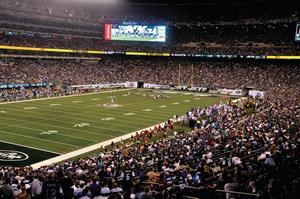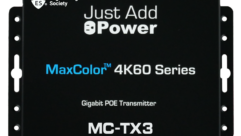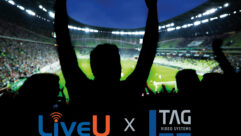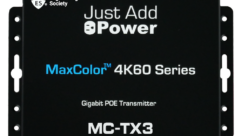

New Meadowlands Stadium: Not Just a Video Masterpiece
Much has been written about the massive video intrastructure at New Meadowlands Stadium and they way it delivers content to every visitor. But the audio system is also cutting-edge.
CHALLENGE: Design an audio system for a new 21st-century sports stadium that’s as impressive as its video system.
The old joke goes something like this: “Where are you from?” “New Jersey.” “Oh really? Which exit?” The reference to the Garden State’s endless miles of interstates, parkways, and turnpikes may be clichéd, but now at least one of those exits (16W off the New Jersey Turnpike, to be precise) gives the locals some serious bragging rights. And it has become a case study in more than cutting-edge video delivery.
SOLUTION: Model a large distributed sound reinforcement solution with precision programming that takes into account the stadium’s unique architecture.
The tiers at the New Meadowlands are closer together vertically than they would have been a decade ago to allow for more glass-enclosed VIP seating. That posed an acoustical challenge.
Credit: Pro Media/Ultrasound
Much has been written about New Meadowlands Stadium, built just miles from the Manhattan skyline and home to the National Football League’s New York Giants and New York Jets. It was erected at a cost of $1.6 billion, and spreads out over nearly 80 acres of what was once wetlands but more recently was the site of the old Giants Stadium, a moniker that always irked fans of the stadium’s other football tenant.
A true multipurpose venue, designed to also host Major League Soccer matches, college football games, concerts, and other events, the New Meadowlands Stadium seats up to 82,500 and includes a massive, fiber-optic-based IPTV network from Cisco Systems and Verizon Communications that brings video highlights, game information, and digital signage to nearly every fan (see “5-Minute Interview” with Cisco’s Thomas Wyatt, page 10).
In addition to media from its internal content delivery network, the new stadium also draws and distributes DirecTV and Verizon FiOS sources to an estimated 2,200 displays around the stadium, including throughout the extensive premium and club seating sections. Data streams at around 10 Gbps and can reach up to 20 Gbps running over fiber and augmented Cat-6 cabling. The LAN is built around Cisco Catalyst 6500 switches at the edge and Nexus 7000 switches in the core. Wireless hotspots throughout allow visitors to keep tabs on all their favorite sports teams from their handheld devices.
But the New Meadowlands Stadium is also a triumph of acoustics, and it is a creature of changes in modern stadium design that have forced AV professionals to think differently about the sound systems they specify and integrate.
Wrightson, Johnson, Haddon & Williams (WJHW), a Dallas-based consulting firm, handled design of the audio, video, control, and data systems of the stadium, including cabling, telecommunications, security, network broadcast systems, SDI distribution, large-format video displays, IPTV, and an integrated Crestron control system. In light of the complexity in designing stadiums such as the New Meadowlands, Jim Faber, a senior associate at WJHW, is reluctant to call what his company does as working on “AV systems” anymore.
“We’re using the term ‘electronic systems’ now instead of AV systems,” he says. Faber believes projects such as the New Meadowlands portend the day, in the very near future, when the electronic systems contractor is a primary trade supplier on par with the electrical or mechanical contractor, calling in audio and video specialists as needed.
To tackle the audio challenge presented by the New Meadowlands Stadium, WJHW brought in Pro Media/Ultrasound. The two got down to business designing a sound system that took into account the venue’s decidedly 21st century architecture.
New Meadowlands Stadium: Not Just a Video Masterpiece
Much has been written about the massive video intrastructure at New Meadowlands Stadium and they way it delivers content to every visitor. But the audio system is also cutting-edge.
THE SOUND SYSTEM
Getting the Sound Just Right
The AV team working on the New Meadowlands Stadium had to employ extensive predictive modeling during the design phase to ensure the sound systems would perform as needed. “It was time well spent,” says Mark Graham of Wrightson, Johnson, Haddon & Williams (WJHW). “We were very pleased with the similarities in system performance in the venue when compared to the modeled predictions.”
WJHW started with a 3D rendering of a section of the stadium and modeled acoustical performance using EASE software to predict frequency response and the arrival time of sound at specific seats in the stadium. The process stretched out over several weeks, first to generate raw data for a system with 954 loudspeakers, then for tweaking the EQ and levels of various individual speakers in the virtual domain to the point that they performed as perfectly as possible.
The cancellation prediction chart (top chart) generated in EASE predicts the frequency response at one specific seat in the club level. The red line indicates the output of a speaker attached to the face of the upper deck above, while the blue line shows the low-frequency notch at the same seat when a cancellation speaker is implemented. Level in decibels is on the vertical axis and frequency is shown on the horizontal axis.
The reflectogram shows the level and time arrival of all the speakers in the stadium at a different seat in the lower level. With a distributed audio system, any sound that arrives at a given point should do so within a 30-millisecond window. If it arrives later, it should be at a minimum level of -10 dB compared to sound arriving within the 30-millisecond window. The graph shows that the first speaker on the Y axis delivers the first and strongest sound arrival, followed closely by other speakers nearest the listener’s seat.
Architecturally, the New Meadowlands Stadium is a reflection of its time. It has as muchor moreclub and premium seating as any of the new generation of ballparks that came before it, such as the new Yankee Stadium, the New York Mets’ Citi Field, or Lucas Oil Field in Indianapolis. Like air travel and hotels, major league sports today are all about the upgrade and enhancing the fan experience in order to sell more high-revenue luxury seats. As a result, the tiers at the New Meadowlands are closer together vertically than they would have been a decade or two ago to allow for more glass-enclosed VIP seating.
WJHW associate Mark Graham was tasked with maximizing the sound quality in what at the time was still considered a nontraditional acoustical environment. “You might not think acoustics plays a big role in the sound for an outdoor situation, but it does, especially with this kind of bowl architecture,” he says.
Fans have come to expect concert-level sound quality in stadiums, even if they’re not attending a concert. Graham’s challenge was to accomplish that effect in a huge bowl enveloping the playing field, where speakers of sufficient throw to cover their particular areas might normally bleed over and create a perceivedand very annoyingecho effect. Moreover, speakers placed toward one end of the stadium would be audible to fans sitting toward the other end of the bowl. Sound traveling across the open space between them would be direct sound, not reflected, but would also be perceived as an echo.
Even the solutiona large distributed sound system with carefully programmed delays—wasn’t as straightforward as it seemed. “The collapsed ceiling heights between levels, due to all the premium seating they had packed into the stadium’s design, meant that the speakers overhead would be much closer than usual to fans in the stands directly below,” Graham says. “A speaker might be capable of throwing up to 100 feet or more, but it might have to placed as close as 20 feet above their heads.”
New Meadowlands Stadium: Not Just a Video Masterpiece
Much has been written about the massive video intrastructure at New Meadowlands Stadium and they way it delivers content to every visitor. But the audio system is also cutting-edge.
Additional components of the distributed audio system include JBL AC18 boxes along the two middle tiers to cover the club and suites level, as well as the main seating area. Even more loudspeakers are situated at field level, with six customized JBL 2217 HPL woofer enclosures. The field speakers are located at the ends of aisles and are designed to be removed for events, such as concerts, when access to the field is necessary via portable stairs.
To counter this, Graham decided that speakers would be placed on the fascia of the stadium’s various levels, which presented more challenges. LED ribbon boards running the length of the stadium’s interior meant that the audio team had to move to the upper level to find adequate space for attaching the largest boxes. And the further up they positioned those speakers, the more powerful the loudspeakers had to be. And of course, because the speaker system was mounted externally, all the boxes needed to be weather-resistant.
Graham settled on a dual-box configuration in which a JBL PD5322/64 three-way loudspeaker was coupled with a JBL AL6115 high-power, low-frequency loudspeaker with a front-loaded 15-inch vented gap cooled low-frequency driver. Both were weatherized using JBL’s own WRX protection (many other installed JBL speakers also have WRK protection). “We added the AL6115 to direct more low frequencies to the far seating by band-passing them and adding some delay to steer the lows forward, creating a null just below them,” Graham explains.
The combination fires downward toward the seats with sufficient power to cover the 150 feet between the speakers and the stands. However, aiming was crucial.
“At these distances, you have less control of the sound, and that’s where you start to experience cross-field [echo-like] effects,” Graham says.
He based the initial aiming on predictive models created in JBL’s EASE modeling program. Those models were given to AV integrator Pro Media/Ultrasound, which agreed to first perform a full-scale test of the models on a small sliver of the stadium while it was still under construction.
After positioning and firing test signals through the speakers, then measuring the results, Pro Media/Ultrasound chief operating office Ted Leamy took the data back to Graham, who used the information to more precisely fine-tune the aiming in the virtual CAD model.
“Mark was able to readjust aiming angles in the modeling program so that by the time we actually installed the speakers in the stadium, virtually no further adjustments were necessary,” Leamy says. “It was a case of ‘measure twice, cut once.”
The New Meadowlands Stadiums video systems may get all the glory, but its massive distributed audio installation delivers concert-level sound and can adapt to multiple tenants.
Credit: Pro Media/Ultrasound
The delays are applied progressively from top to bottom, with the speakers on the light truss over the upper deck getting no delay and the field-level speakers getting the greatest amount of delay. This creates a smooth transition between sections of the raked seating, while at the same time addressing the cross-field issue.
“Anytime you hear the cross-field speaker longer than 30 milliseconds, it will be perceived as an echo,” says Graham. “By choosing the right speakers and aiming them so that we knew exactly what the arrival times of the sound would be everywhere, we took care of it.”
In total, the New Meadowlands Stadium includes 1,050 JBL speakers in the main bowl, powered by 462 Crown CTs 1200, CTs 2000, CTs 3000, CTs 4200, and CTs 600 amplifiers connected over a HiQnet System Architect network. EQ is handled in System Architect at the amplifier level. There are 600 more JBL, Tannoy, and Atlas speakers in clubs, corridors, restrooms, and other ancillary areas, with Community R.5 speakers servicing the open concession areas. All the loudspeakers are controlled using a combination of Peavey NION and System Architect.
Graham says complex solutions for distributed sound in venues such as the New Meadowlands Stadium could become the norm. “When distributed systems first came into vogue 20 years ago, stadiums were being designed with a lot more space in between their tiers,” he says. “As they collapse them to add more premium seating, it adds more intricacies to the system design. The choice of the speaker is also important and the JBL PD5000 series is a great-sounding box that gives you a lot of control.”
New Meadowlands Stadium: Not Just a Video Masterpiece
Much has been written about the massive video intrastructure at New Meadowlands Stadium and they way it delivers content to every visitor. But the audio system is also cutting-edge.
AN AV TABLA RASA
EQUIPMENT LIST
Below is a partial list of the sound equipment specified and installed by Wrightson, Johnson, Haddon & Williams and Pro Media/Ultrasound for the New Meadowlands Stadium.
- 374 Atlas Sound FAP42T speakers
- 579 Atlas Sound FAP62T ceiling and ceiling pendant speakers
- 1 Avid Digidesign SC48 console
- 130 Community Pro R.5-99TX speakers
- 10 Crestron Electronics TPMC-15-QM-LB touch panels
- 8 Crestron Electronics TPS-6L touch panels
- 10 Crestron Electronics Rack2 controllers
- 52 Crown CTs 1200 and CTs 1200 LITE amps
- 142 Crown CTs 2000 and CTs 2000 LITE amps
- 78 Crown CTs 3000 and CTs 3000 LITE
- 8 Crown CTs 4200-IQ amps
- 20 Tannoy DI8 DCt speakers
- 788 JBL Control 226C/T, 322CT, 328CT, and 19CST ceiling speakers and subwoofers
- 441 JBL AM6212/64, 6212/95, and 6215/95 weatherized speakers
- 675 JBL AC16, AC18/26, AC18/95, and AC28/95 weatherized speakers
- 30 JBL AL6115 weatherized cancellation woofers
- 78 JBL PD5322/64 weatherized speakers
- 36 JBL ML6134 Meadowlands weatherized woofers
- 2 Lectrosonics IFBR1a receivers
- 2 Lectrosonics IFBT4 transmitters
- 2 Lectrosonics R400A diversity receivers
- 5 Listen Technologies LT-800-216 assistive listening transmitters
- 32 Listen Technologies LR-400-216 ALS receivers
- 42 Listen Technologies LA-362 ALS receivers
- 48 Listen Technologies LA-164, LA-165, and LA-166 ALS headsets
- 3 Listen Technologies LA-122 universal antenna kits
- 5 Optocore DD32e digital fi ber I/Os
- 3 Optocore X6P-8/8 analog A/D interfaces
- 2 Optocore DD6NE Ethernet module interfaces
- 24 Peavey Electronics NION N3 digital signal processors
- Roland AR3000 IP message repeater
- Sennheiser System 5000 wireless receiver
- Sennheiser System 5000 wireless handheld transmitter
- Sennheiser SR 300 IEM G3 in-ear transmitter
- 4 Sennheiser EK 300 IEM G3 in-ear receivers
- 5 Shure 577B gate page mics
- 5 Shure UR124S/Beta87A wireless mic systems
- 4 Shure UR124D/Beta87A dual wireless combos
- 10 Shure UA860SWB antennas
- 5 Shure UA221 antenna couplers
- 4 SurgeX SX-1120RT surge protectors
- 2 Symetrix 322 DSP modules
- Symetrix 528E analog voice processor
- 2 Yamaha MS101 monitors
Source: Pro Media/Ultrasound
Because of its multipurpose design, the New Meadowlands Stadium also has a unique mixing console solution. An Avid Digidesign Venue SC48 console can be used indoors or out (weather-permitting, of course), in the main control room, or on the field. The SC48 is configured as a tour sound console, allowing it to be moved just as any live sound console would, and an Optocore system is used to route audio from the field to the audio control and video replay room, as well as the broadcast dock.
That same Optocore system allows the mixing console to be moved to secondary outdoor locations using connectors located at the camera platforms. “Usually, the mixer sits inside the control room and sees the action from behind the glass. If he’s lucky, the window will open,” says Leamy. “This approach lets the mixer be in the same environment as the fans. The mixer will hear the sound the way the audience will hear it.”
Since the New Meadowlands essentially hosts two main co-tenants, the venue itself had to be the digital equivalent of a tabla rasa. “It couldn’t be [Giants] blue, it couldn’t be [Jets] green,” Leamy says. “It had to be neutral, and the systems help it achieve that, to let each team ‘own’ the stadium when they are there.”
The effect is accomplished mainly through digital signage and displays, particularly the five pylon-marked entrance gates and Daktronics videowalls that can be fed content either locally or from the central control room via Cobranet. The video displays also receive tailored audio; arriving fans are greeted by Jets or Giants music and information though various JBL AM and AC series speakers.
That flexibility extends to the four main VIP clubs, which can also act as standalone space and tie into the same content feeds that guests encounter at the stadium gates. A Peavey NION media matrix DSP handles source selection and message repeater functions. “The fan experience has to start from the moment they get out of their car and stay with them wherever they go throughout the stadium,” Leamy says.
Control is critical to keeping this digital content ballet on its toes. Much of that is handled by one of the largest Crestron Rack2 Series control systems ever deployed in a commercial application. The Crestron system manages the audio, video, and lighting in all the VIP club settings, plus it integrates Cisco’s StadiumVision systems to control the clubs’ TV monitors.
The same Series 2 system and Rack2 processors are also integrated with building management systems using Crestron’s GLA-BMS system and RoomView server software to enable global presets received from the Schneider Electric Square D power distribution and control system to set certain signage, lighting, and audio to predefined macro levels, such as “Jets Night Game,” “Giants Day Game,” or “Concert Setting Night.” Leamy’s emphasis on letting each team set the tone for its games even extends to the backlighting on the stadium’s touch panels, which come up green or blue on game day (for other events, they default to gray).
“The biggest challenge here was the scope of the programming,” says Ian McDermott, Crestron’s senior systems engineer on the project, who estimates there are about 500 lights and display circuits riding on the system.
The trick was to make each individual space as customizable as possible, but also have them all play nicely together on the network. In theory, a single button can turn on or off all the lights, set the channel on a TV and adjust audio levels for any one club space, or all of them. “I’ve never encountered this level of integration before,” McDermott says.
THE POWER OF (A SEPARATE) NETWORK
In a roundabout way, the strength of the New Meadowlands Stadium’s distributed audio systems owes a lot to its high-tech video systems. The IPTV network is run out of the centrally positioned telecommunications room, adjacent to the stadium’s broadcast center and production studio, as well as the main security control room.
WJHW’s Faber says that while this proximity of electronics nerve centers was unintentionala byproduct of the larger architectural designit worked out well in terms of cabling efficiency.
Faber says WJHW has worked with a dozen IPTV systems like the one for the New Meadowlands Stadium, but it’s still new enough that he gets pushback from unlikely sources. Although management was gung-ho about an IT-based audio/video network, there was enough concern about running CobraNet on a converged network that in the end it was decided the sound systems would have their own dedicated network.
“Contractors aren’t used to [the idea of converged networks] yet,” Faber says. “They want to stay in their comfort zone. The problem is, developments on the IT side are moving so fast that they’re actually becoming disruptive.”
Faber says he’s looking forward to designing future venues with a single unified network, which he says will facilitate ease of intercommunication and make data mining feasible. Such a network could help grow revenue streams for leagues, teams, and venue owners even more than the impressive AV installation off exit 16W in New Jersey.
Dan Daley is a freelance AV writer and frequent contributor to Pro AV.










